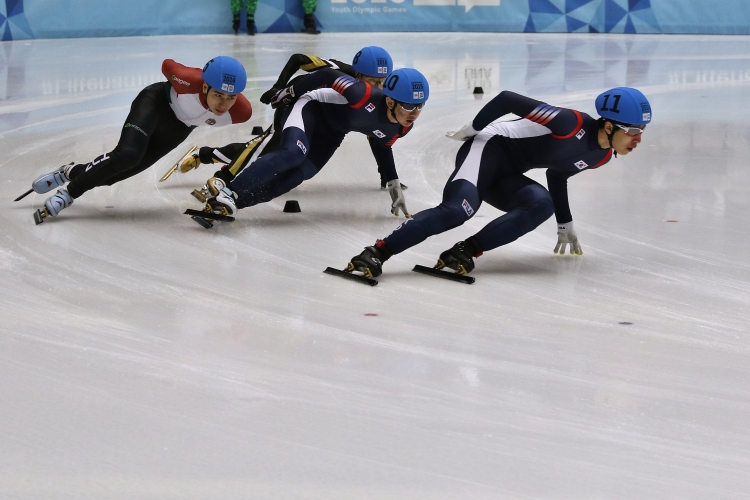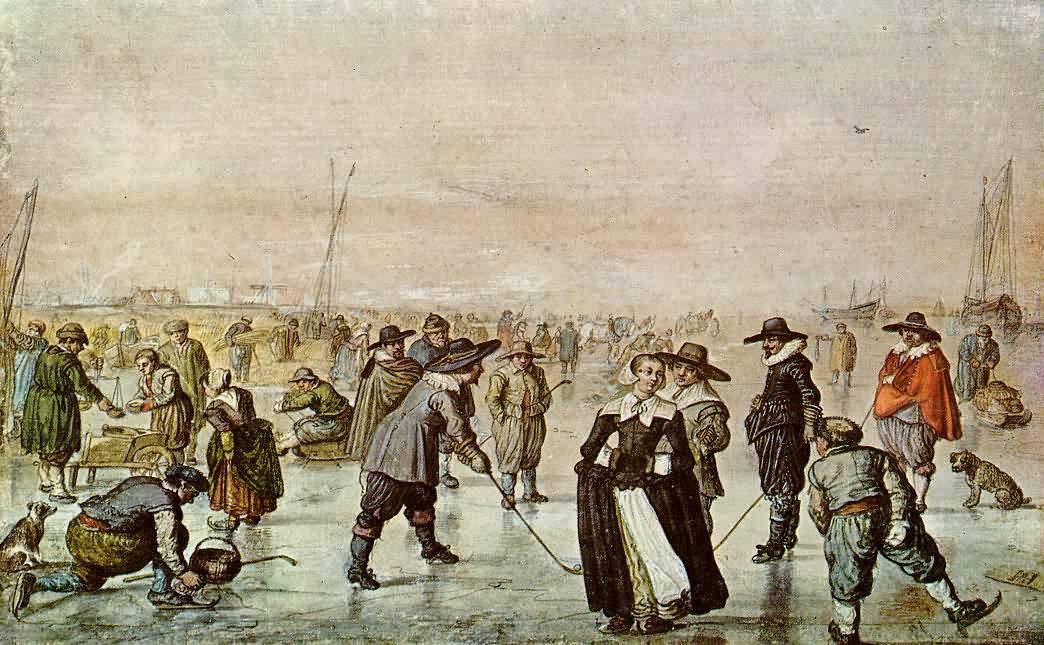On Ice

As the Winter Olympics grace our airwaves once again, our attention turns toward winter sports. While speed skating is one of the most viewed sports in the Winter Olympics, very few spectators understand exactly what it entails. Speed skating is a broad term used to describe two different sports, short and long track skating. While short track speed skating was only developed around the beginning of the 20th century, long track speed skating has an extensive history that provides context and depth to the sport. From the 13th century until roughly the 17th century, Holland had a sort of mini Ice Age. In order to make travel under these conditions possible, long skates were used to traverse the frozen canals, lakes, and other waterways. Not long after, the British strapped blades to their feet and took to the ice, followed by the French with others soon following suit. Eventually, as the ice covering Holland slowly diminished, the Dutch began to experiment with competitive speed skating. According to the ISU (International Skating Union), the first speed skating competitions were most likely held in 17th century Holland, but there were no officially documented competitions until 1863.
Image Credit: Wikimedia Commons / Hendrick Avercamp
Twenty-six years later, in 1889, skaters from four different countries met on the ice in the speed skating homeland for the first speed skating World Championships. This competition brought men from both sides of the pond to race the 500m, 1500m, 5000m, and 10,000m. While skaters of this era were unable to reach the speeds achieved by today's skaters, commonly well over 30mph, they could still traverse the 500m track in well under a minute.
At the beginning of the 20th century, speed skating competitions were drawing some public attention, particularly in Northern Europe, but opportunities for athletes to skate in high-profile, international competitions were limited to the Nordic Games and the World Championships. Often Winter sports were featured during the Summer Olympics, however, it was not viable to hold a 10,000-meter race on an indoor rink.
It was not until 1924 that speed skating began to develop into an international sensation, as the French National Olympic Committee and the International Olympic Committee had chosen to organize a Winter Olympics. Held in Chamonix, France, the Winter games attracted approximately 10,000 spectators and athletes from 16 different countries. Out of only six sports featured at the Chamonix Games, speed skating made the cut and established itself as an Olympic favorite. While the Winter Games paled in comparison to their summer counterpart, Time Magazine wrote that the then-President of the IOC considered the Games a great success.
Of course, there was some controversy surrounding the establishment of the Winter Games as the organizers of the Nordic Games worried that a Winter Olympics would overshadow their competition, however, the IOC found a compromise, stating that the two-week winter event would simply be a celebration of the success of the modern Olympic Games and 1924 Olympic Summer Games, held in Paris. All parties agreed to an International Week of Winter Sports and it was not until the following year that the IOC officially dubbed the 12-day event the first Winter Olympic Games.
Another landmark came only eight years later during the 1932 Winter Olympic Games held in Lake Placid, when the ISU and the organizers of the Games made a bold move by adding a mass start to the speed skating program. Many Europeans boycotted the event as speed skating races had always been conducted in the European style, with two athletes racing in separate lanes competing for the best overall time and European skaters disapproved of this North American racing style creeping into the Olympics. The boycott allowed American speed skaters to pick up four gold medals that year, alone. Since the 1932 Games, the mass start has not been seen again in the Olympics until this year, when it will be added to the long track program once again. This choice likely has to do with the popularity of the mass start in recent years as it has been included in a few major competitions. Perhaps more importantly, the 1932 mass start led to short track speed skating establishing a presence in Europe.
Short track skating began on the North American side of the Pond, with skaters from Canada and the United States racing in mass starts as far back as 1905. Over the next few decades, as the Winter Olympics were established, short track open competitions began to emerge, as the sport was not officially indoctrinated into the ISU until 1967. The IOC stated that countries such as Japan, Great Britain, Belgium, Australia, and France were instrumental in the sport gaining enough momentum to eventually be considered an official sport by the ISU as athletes from these countries participated in short track competitions long before official competitions were being held.
Exactly 25 years after short track was indoctrinated into the ISU, it made its Olympic debut at the 1992 Albertville Winter Games. While it had been featured as a demonstration sport four years previously at the Calgary Winter Olympics, the video below presents the first ever Olympic short track race.
In this sport, groups of between four and seven athletes race together on a single 111m track, jockeying for first position. Rather than racing the clock, these athletes race each other. Advancement into the finals is based on the place a skater achieves in their heat with the skater coming in first always guaranteed a spot in the next round. This is the only Winter Olympic sport structured this way, as all other racing sports involve one or two athletes racing for the fastest time.
The sport posed a wealth of new challenges for athletes as, due to the short straightaways and sharp turns, the physics involved had altered drastically. Techniques began to evolve as skaters learned which muscle groups were involved and understood the greater need to remain aerodynamic in short track. Equipment began to change as well, boots were redesigned and additional protective equipment became necessary with the helmet eventually being added in 1984.
Short track skaters only skate three regular distances, the 500m, 1000m, and 1500m, along with a 3000m superfinal in some competitions and, of course, the relay. Until short track, a relay on the ice was unviable, but today, teams of four short track athletes race in the 5000m relay for men and the 3000m relay for women. The relay is perhaps the most exciting and chaotic event in either short track or long track and is often a favorite of both athletes and spectators. Rather than the passing of a baton, skaters exchange in the relay by passing their speed to the next skater in the rotation. In each exchange there is always a skater on the track racing and a skater just inside the track matching their speed, ready to make the exchange. After a lap and a half, the inside skater will move onto the track at the end of the turn, just ahead of the skater on the track. The skater on the track pushes the next skater, allowing all of the speed they have generated in that lap and a half to flow into their teammate. It is an extremely technical maneuver, particularly in an international competition in which every skater is racing under nine seconds per lap.
The skill and dedication required for short track speed skating might be one of the reasons why it has remained so small. Additionally, it is highly unpredictable. Athletes can train for years and reach the highest level of the sport only to fall in an Olympic final. So, while many individuals try the sport and might even skate for years, very few continue at the breakneck pace required to truly achieve excellence. Short track is also so physically demanding that injuries can result from improper self-care, leading to many skaters leaving the sport before they might have liked to. While other sports may have training regimens which are just as rigorous, it is short track speed skaters who must travel at speeds up to 40mph propelled by nothing but their legs.

Image Credit: Wikimedia Commons / Pawel Maryanov
Over the years, both short and long track have generated some incredibly successful athletes. In long track, a few athletes from the United States, such as Eric Heiden ( five-time Olympic gold medalist), Bonnie Blair (six-time Olympic medalist and before 2010 the most decorated American Winter Olympian of all time), Shani Davis, and Eric Flaim both of whom actually competed in long track and short track, have established the US as a successful country in long track skating. However, the Dutch athletes have always dominated long track, and of the 117 Olympic medals won by the Dutch, 111 were in long track speed skating. In short track, South Korean and Chinese athletes such as Lee Jung-Su, the two-time Olympic gold medalist from South Korea, and Wang Meng the six-time Olympic medalist from China, have monopolized the sport in recent years. Athletes from South Korea currently hold seven out of the eleven possible world records. Other athletes who stand out include Viktor Ahn (pictured above) and Apolo Ohno, both of whom are currently tied as the most decorated Olympic speed skaters of all time. Ohno holds the title as the most decorated American Winter Olympian, having obtained eight medals throughout his respective career.
The 2018 Pyeongchang Winter Olympic Games mark another important moment in short track history, particularly for Americans as. Even though women's speed skating has been included in the Olympic program since 1960, it was not until this year that Maame Biney and Erin Jackson made history by becoming the first African American women to represent the United States in short track and long track respectively. However, when Team USA was given the opportunity to elect Shani Davis to be the first African American athlete to carry the flag in the opening ceremony of the Winter Games, they failed to do so.
While there are many positive new developments in the last few years of short track speed skating, there have also been several important controversies, such as the Russian doping ban at the 2018 Olympics which involved short track speed skater Viktor Ahn or the controversy surrounding former United States national team coach Jae Su Chun in 2012, who was suspended from US speed skating and returned to train athletes in South Korea. In many respects, short track is still in its infancy, with new techniques being developed, new landmarks being reached, and new challenges being confronted every year. While the sport is incredibly complex and technical, many short track skaters can summarize the entire premise of the sport in four simple words, “skate fast, turn left”.
For those with a need for speed, just outside of Paris in Fontenay-sous-Bois, USF, a French short track speed skating club, skates every week Tuesday through Thursday at the Patinoire Salvador-Allende behind the centre commercial just off RER line E or A at Val de Fontenay.








